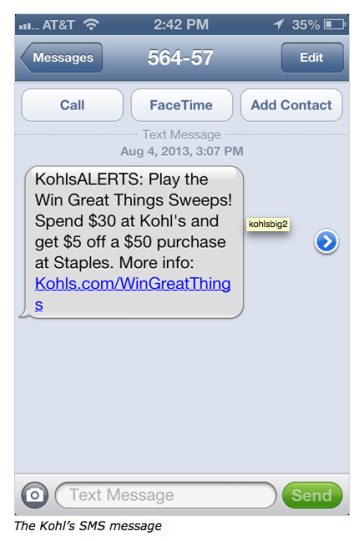With the enhancements of modern day technology, consumers have become “more and more comfortable with and reliant on digital communication solutions, including the mobile phone”. The phone has become a primary means of communication among consumers, not only for voice but also for digital services such as e-mail, photos, and text messages or “SMS Messages”. With this change in communication, marketers must take notice and develop marketing plans accordingly.
Mobile Advertising – Kohl’s “Win Great Things” Sweepstakes
As a department store, back-to-school shopping is an important time to be on top of consumers’ minds. In 2013, Kohl’s took a different approach for its back-to-school campaign by giving mobile a more prominent role. The campaign was called the “Win Great Things” sweepstakes, which rewarded shoppers with coupons and online game pieces that could be used to win prizes from brands including Keurig, Apple’s iTunes and JanSport.
Throughout the campaign, Kohl’s sent out SMS blasts promoting the sweepstakes to  consumers that had opt-ed in to its mobile alerts program, Kohl’sAlerts. The text informed consumers if they spent $30 or more at Kohl’s, they would receive a coupon for $5 off a $50 purchase at Staples. The blast also included a link to the microsite for the campaign, where consumers could learn more about the sweepstakes and how they could receive and claim game codes. For every $30 that consumers spend at the store, they would receive one game piece to win prizes. Prizes could be claimed in store, online, and through the microsite that was provided in the SMS blast.
consumers that had opt-ed in to its mobile alerts program, Kohl’sAlerts. The text informed consumers if they spent $30 or more at Kohl’s, they would receive a coupon for $5 off a $50 purchase at Staples. The blast also included a link to the microsite for the campaign, where consumers could learn more about the sweepstakes and how they could receive and claim game codes. For every $30 that consumers spend at the store, they would receive one game piece to win prizes. Prizes could be claimed in store, online, and through the microsite that was provided in the SMS blast.
Savvy shoppers are always looking for the best deal and back-to-school shopping is no exception, but will sending a text message about a discount help persuade them to shop at Kohl’s? According to the International Council of Shopping Centers, roughly 90% of shoppers are persuaded to visit stores because of money-saving sales. Parents and students are price sensitive and continuously hunt for a combination of good prices, quality, and style. Kohl’s is meeting consumer needs by not only offering sales, but also by providing additional discounts on the back-to-school essentials and opportunities to win prizes. Additionally, the partnership between Kohl’s and Staples provides consumers with more ways to save. Furthermore, the SMS blasts provide convenient reminders for shoppers about the promotion and an easy way to enter their game codes to see if they won a prize.
Since shoppers had to sign up to receive the SMS marketing messages, the overall consumer experience in using this approach was positive. These shoppers have demonstrated that they are already invested in the company and are open to receiving information. The SMS messages served as a nice reminder on how shoppers can save money during back-to-school shopping and not viewed as spam invading their personal space. “Additionally, since 98% of mobile phones have the ability to receive SMS messages, there are no downloads necessary, no technology learning curves, and no behavior modifications required, all making for an easy, user-friendly opportunity for customers to take action.” Plus, shoppers can easily opt out whenever they no longer wish to receive messages.
What are your thoughts on text messages from brands? Annoying or effective?

I think that depending on the vertical a brand is in will determine whether or not the SMS messaging will be successful (at least in my opinion). I currently receive text updates from my hair salon. It lets me know when my appointment is or if it has been a long time since I have made an appointment. Brands who want to venture in to text campaigns need to take a look at what the consumer would want out of that campaign. Kohls’ campaign was great although I feel that some consumers would feel overwhelmed by the SMS messages, similar to how they do with email. Texting too much can be an issue with text campaigns. I will say that it was a great add-on that Kohls only send the text campaigns to those who have opted in. This is not always the case. If a brand has this information, they may use it. In truth, anytime you give information to the brand, you are “opting in” to any promotions they may have (until you opt out of course). Consumers may ignore the texts or delete them if they are sent to often. Finding the right amount is tough and brand will need to consider how often they plan to text consumers over a period of time.
LikeLike